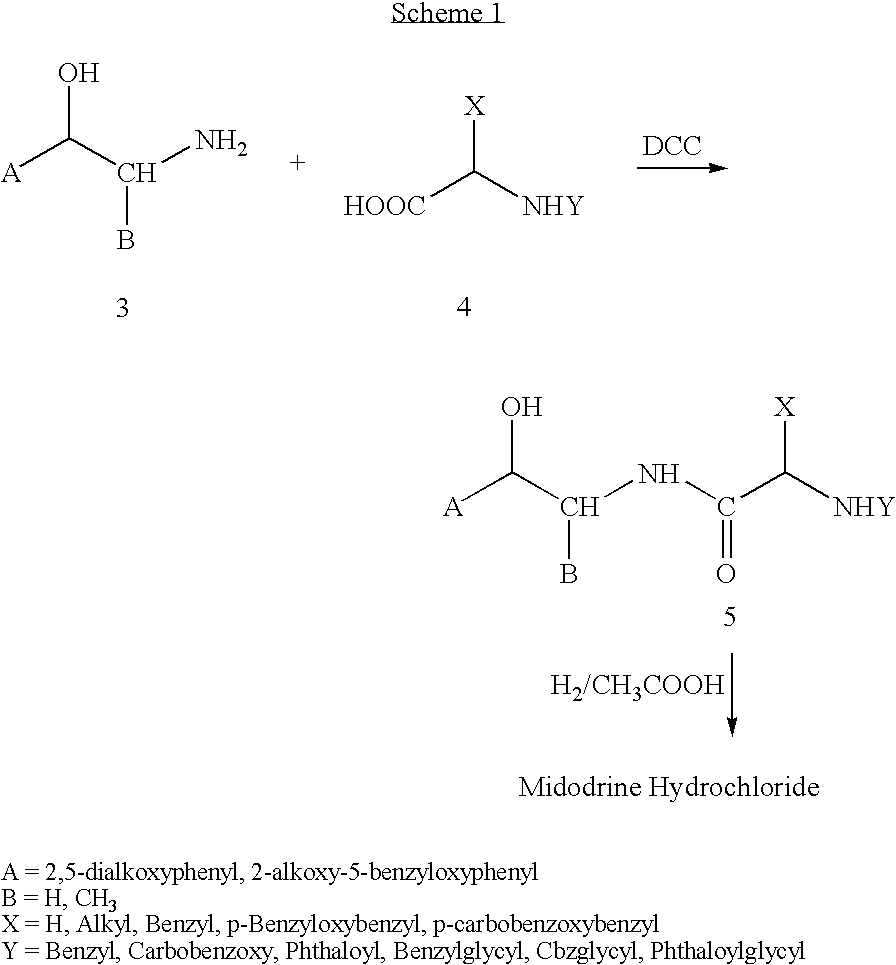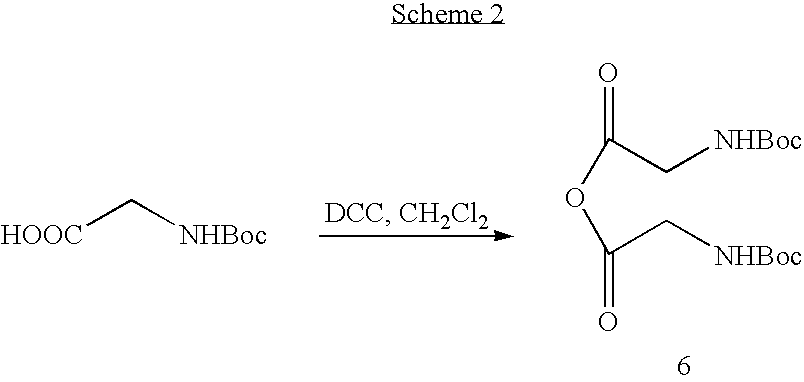Process for the preparation of midodrine, pharmaceutically acceptable salts thereof and intermediates
- Summary
- Abstract
- Description
- Claims
- Application Information
AI Technical Summary
Benefits of technology
Problems solved by technology
Method used
Image
Examples
example 1
[0045] Preparation of Midodrine Hydrochloride
[0046] 1,1′-Carbonyldiimidazole (45.32 g, 0.279 moles) was suspended in ethyl acetate (100 ml). To the beige suspension is added portionwise N-tert-butoxycarbonyl glycine (48.95 g, 0.279 moles). After stirring for 1 hour, this solution was added to a suspension of 2-amino-1-(2′,5′-dimethoxyphenyl) ethanol (50.0 g, 0.253 moles) in ethyl acetate (250 ml). The reaction mixture is stirred at room temperature for 1 hour. A solution of 8% hydrochloric acid (220 ml, 2.2 equiv.) is added to the reaction mixture and the mixture stirred at room temperature for 15 minutes. Stirring is discontinued and the phases are separated. The organic layer is sequentially washed with water, sodium hydroxide 2.5% and water and then dried over sodium sulfate. To the clear ethyl acetate solution is added hydrochloric acid 32% (76 ml, 3 equiv.) and the white suspension stirred at room temperature for 4 hours. The white solid (Midodrine Hydrochloride: 63.9 g, 87%)...
example 2
Preparation of Midodrine Hydrochloride
[0051] 1,1′-Carbonyldiimidazole (45.32 g, 0.279 moles) was suspended in ethyl acetate (100 ml). To the beige suspension is added portionwise Carbobenzyloxyglycine (58.36 g, 0.279 moles). After stirring for 1 hour, this solution was added to a suspension of 2-amino-1-(2′,5′-dimethoxyphenyl) ethanol (50.0 g, 0.253 moles) in ethyl acetate (250 ml). The reaction mixture is stirred at room temperature for 1 hour. A solution of 8% hydrochloric acid (220 ml, 2.2 equiv.) is added to the reaction mixture and the mixture stirred at room temperature for 15 minutes. Stirring is discontinued and the phases are separated. The organic layer is sequentially washed with water, sodium hydroxide 2.5% and water and then dried over sodium sulfate. After distillation of the majority of the ethyl acetate layer, to the solution is added 400 ml of acetic acid and 7.5 g 5% Pd / C. The suspension is then hydrogenated at 60 psi and 60° C. for 24 hours. On reaction completi...
PUM
| Property | Measurement | Unit |
|---|---|---|
| Temperature | aaaaa | aaaaa |
| Temperature | aaaaa | aaaaa |
| Temperature | aaaaa | aaaaa |
Abstract
Description
Claims
Application Information
 Login to View More
Login to View More - R&D
- Intellectual Property
- Life Sciences
- Materials
- Tech Scout
- Unparalleled Data Quality
- Higher Quality Content
- 60% Fewer Hallucinations
Browse by: Latest US Patents, China's latest patents, Technical Efficacy Thesaurus, Application Domain, Technology Topic, Popular Technical Reports.
© 2025 PatSnap. All rights reserved.Legal|Privacy policy|Modern Slavery Act Transparency Statement|Sitemap|About US| Contact US: help@patsnap.com



